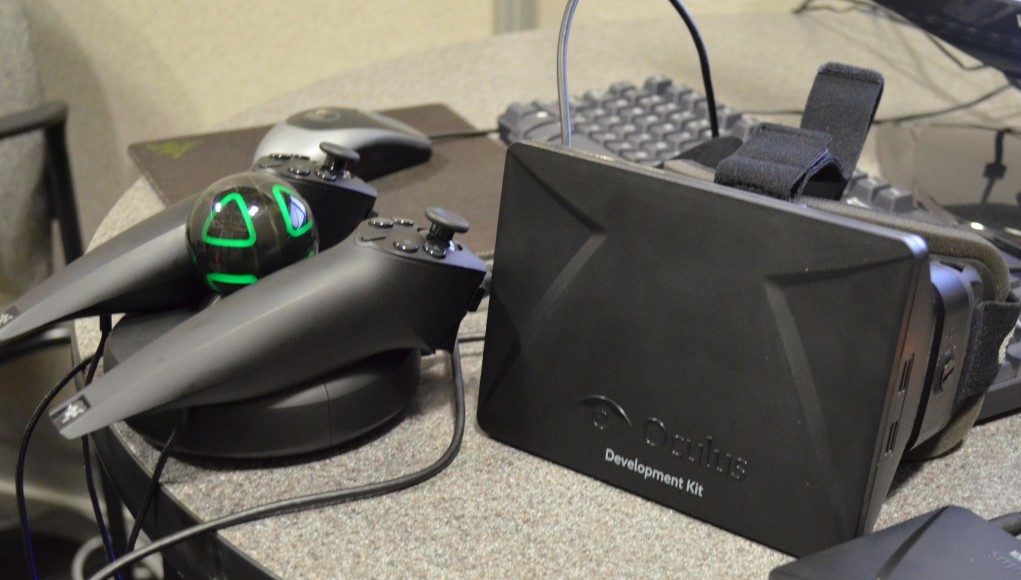At GDC 2013 I met with the good folks from Sixense, makers of the Razer Hydra controller. They put me into the Oculus Rift and loaded up the Tuscany demo (built in Unity). This particular version of the demo has full Razer Hydra support, thanks to Sixense. Scattered around the space is a myriad of physics-driven objects to interact with — and damn is it fun! The combination of the Oculus Rift and the Razer Hydra is potent and incredibly immersive. The Tuscany demo, infused with support for the Razer Hydra, is hands-down the most fun I’ve had in virtual reality yet.
The Oculus Rift and Razer Hydra Are a Winning Combo
If you intend to develop for the Rift and haven’t jumped on the Razer Hydra bandwagon yet, I highly advise that you do so (don’t miss their current sale).
Interacting with the Tuscany demo using the Razer Hydra was not only natural — it was fun! Reaching out and touching objects with your own virtual hands is miles more immersive than using a keyboard and mouse. You can do things with the Rift and the Hydra that you simply can’t do with a monitor and traditional input.
The moment that really sold me was when I tossed a basketball up into the air above my head (see 3:35 in the video). I threw it in a way that the trajectory of the ball would have it landing somewhere slightly behind me. My natural reaction was to look at the ball as it was coming down, lean back, and grab it — and that’s exactly what I did. I didn’t have to think to myself, ‘how do I need to move the controls in order to do what I want to do,’ I simply followed the ball as it flew through the air, reached up behind me, and plucked it out of the air.
I was blown away the moment I caught the ball and realized what had just happened. The immersion that comes from the Rift and the Hydra is extremely impressive and vividly promising. The barriers that separate humans and computers are falling away before our very eyes.
A Visit to Tuscany
There was more to the Oculus Rift Tuscany Razer Hydra demo (we’re going to need a shorter name) than the basketball. There were plenty of objects: books, chairs, logs, barrels, etc. Interacting with things felt incredibly natural.
Picking up a book and bringing it close to your face to see detail was really cool. With a book in my hands I couldn’t help but want to open them to see the pages inside — something Sixense says they would have added given more time. Also exciting was the ability to hold out your finger using one of the Hydra’s buttons and trace a line from the cover art on one of the books; the accuracy is quite impressive (0:45 in the video).
Maybe it was that I was tossing heavy barrels hundreds of feet like a superhero, but throwing objects was immensely fun. At first I was releasing objects just a bit too soon, but eventually I got the hang of it and was launching objects clear off of a cliff into the sea below. I nailed the underhand volleyball serve on my first try which was quite satisfying (7:11).
You can easily grab two objects at the same time, or pass and object back and forth between your hands as you manipulate it. There are clear implications for gameplay here: being able to do something with one hand while doing something entirely different with the other hand is natural and useful. Examples that come to mind include holding a flashlight in one hand while pushing open doors with the other, holding a magnifying glass while inspecting an object, hooking two interlocking pieces of something together to form a key or other useful object, or loading shells into a shotgun.
The Tuscany Razer Hydra demo is absolutely the most fun I’ve had yet with virtual reality. Soon, game developers will be wrapping these new natural interactions in compelling narratives and enticing gameplay and I can’t wait to step into those experiences. This is an extremely exciting time to be a gamer!
Sixense tells me that they intend to release this demo to the public in due time — more on that as we hear it.
Discuss this over in our forums.







